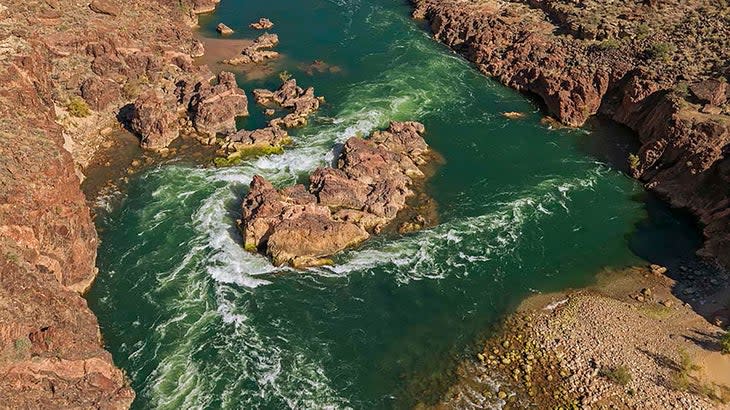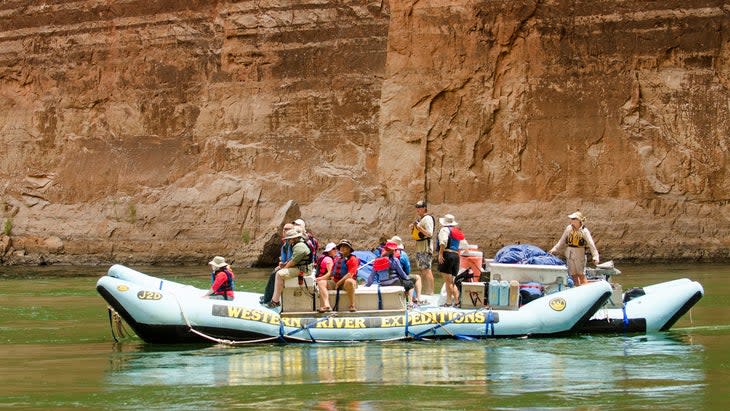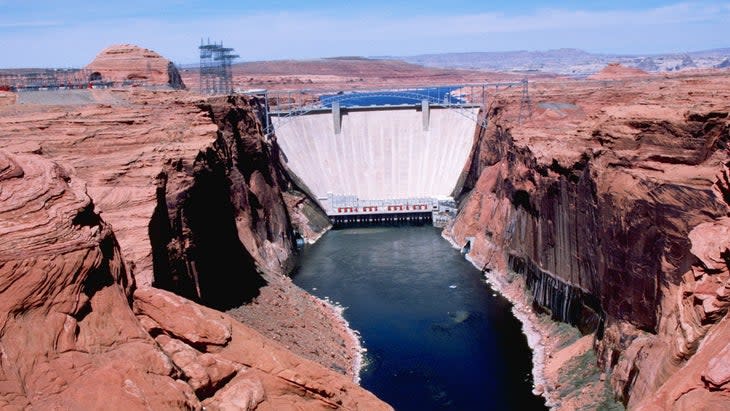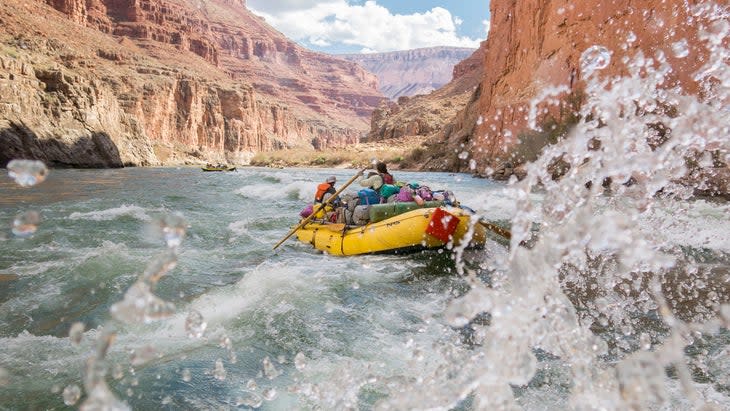The Future of Rafting the Grand Canyon May Be Dry and Deadly
This article originally appeared on Outside
On September 10, 2022, a Grand Canyon rafting trip led by Western River Expeditions was running like clockwork--exactly what the four guides wanted for their 31 passengers, many of whom had never been below the rim before or experienced the thrill of big rapids. The fifth day of the eight-day trip started as usual, with coffee and breakfast in camp. Then everyone climbed aboard the two fully loaded J-Rigs--motorized, 37-foot long, 10,000-pound boats--and the crafts headed downriver in a gentle rain.
Compared to smaller human-powered oar boats that carry four or five passengers, the J-Rigs are more stable in rapids but also harder to navigate in shallow waters and around unanticipated obstacles. By this point in the journey, the group had safely negotiated the three notorious Class V rapids: Hance, Hermit, and Crystal. They had also hiked to the thundering waters of Deer Creek Falls and the fern-decked paradise of Elves Chasm. After several hours on the river, the group stopped for lunch at a small beach called Randy's Rock.
Around 1:30 P.M. the party approached the top of Bedrock rapid, a perilous stretch of whitewater where the river is divided by a hulking island of Vishnu schist, the Earth's oldest exposed rock. Grand Canyon guides call it "Dreadrock" because of the prevalence of accidents there.
The first raft to approach the rapid was piloted by a highly experienced guide who had led 60 Western trips. (His name has been withheld by request of the National Park Service, to protect his privacy.) He explained to his 15 passengers the hazards of Bedrock and the strategy for the run. It was imperative to go to the right side of the giant rock because the channel to the left was dangerously narrow and filled with powerful currents. But the approach on the right side of the river is too shallow for big J-Rigs, so the guide would drift in on the left and motor right as soon as the water was deep enough--the standard way to approach this route. However, the approach was extra shallow on this trip, so he would have to stay in the left channel until they were closer to the rock than usual.

As the boat entered the rapid, the passengers cinched their PFDs and held on to the raft's safety ropes, bracing for another rowdy ride. Some passengers sat at the front of the raft, straddling rubber pontoons on what Western calls "thrill" seating." Others sat in the middle, atop cushioned gear boxes called the "princess pad."
With a total of 133 Grand Canyon trips under his belt, the guide knew Bedrock well. When he was finally in deep enough water, close to the behemoth Bedrock, he revved the craft's 30-horsepower motor to make a hard right. The guide attempted to steer the raft to the right, but it continued to float straight, and the rig bumped up against the rock. The river's powerful current submerged the front of the raft, along with passengers in the "thrill" seats. Then, the entire J-Rig flipped upside down and all 15 passengers and two guides wound up in the churning whitewater.
The Colorado River was lower and more technical than usual in September, 2022--a result of the decade-long megadrought, and the Bureau of Reclamation's decision to reduce water flowing from Glen Canyon Dam. This dynamic meant that Bedrock had become especially tight for large motor rigs--which make up two thirds of commercial trips on the river.
"Lower water in the Grand Canyon complicates runs and leads to far more wraps and flips and people overboard," says longtime guide Michael Ghiglieri, who is co-author of the book Over the Edge: Death in Grand Canyon, which chronicles the many fatalities in the national park. Ghiglieri ran Bedrock just a few days after the Western trip. He noticed changes in the rapid caused not only by lower water but also debris from a recent flash flood that had narrowed the navigable channel.
Before Glen Canyon dam releases were cut back last year, typical daytime flows on the river ranged from 12,000 to 20,000 cubic feet per second (cfs). When the river is that high, Ghiglieri says, "It is predictable and irons out the rapids."
On the afternoon of September 10, when Western was navigating Bedrock, the Colorado River was flowing at 9,040 cfs. By October it would drop to 7,000 cfs. Lower water creates more safety hazards, and Ghiglieri and other guides say that if the flow drops below 5,000 cfs, large motor rigs won't just struggle to navigate some rapids--they may not be able to get through them at all, and trips could come to a standstill.
Even at 9,000 cfs, some of the river's most treacherous rapids are more dangerous than at higher flows--something the Western trip discovered. The second J-Rig on the Western trip managed to successfully navigate the same line and floated to the right of Bedrock, rescuing passengers from the flipped craft along the way. Many of the swimmers were repeatedly pinned underwater by the rapid and later told investigators they believed they were going to die. Eventually, 14 clients were pulled to safety. But one was missing: Ronald VanderLugt, a 67-year old ophthalmologist from Kalamazoo, Michigan. About 30 minutes after the accident, VanderLugt's body was located a mile downstream from Bedrock near the capsized J-Rig. His PFD was still around his chest and he was floating face down in an eddy.

The coroner's autopsy report would identify VanderLugt's cause of death as "freshwater drowning." He had no notable internal or external injuries beyond a banged-up shin. And while an extensive investigation by the National Park Service drew no conclusions on the cause of the accident, the investigation report (obtained by Outside through a Freedom of Information Act request) listed "pertinent known facts": low water in Bedrock, and new flood debris complicating the run. A section on VanderLugt's medical history described his lack of physical fitness. He carried a medication prescribed for chronic obstructive pulmonary disease, a lung condition that narrows airways and constricts breathing.
"VanderLugt struggled on hikes," stated the report, adding that a guide often waited for him to catch up. "VanderLugt did not have good fitness overall, and [the guide had] concerns about his ability to rescue swim during the flip." Both Western River Expeditions and the family of VanderLugt declined to be interviewed for this story.
Longtime boatman Brian Dierker told me the accident as was a random fluke. John Dillon, executive director of the non-profit trade group Grand Canyon River Outfitters Association, agrees. "The boat flip in Bedrock was an incredibly rare and tragic event," he says. "It is a reminder to us all that the river is in charge and respects no one. Anything can happen to anyone at anytime, even to the very best and most experienced."
VanderLugt's death was the first drowning fatality for Western in its 61-year history. But as climate change continues to shrink the West's water supply and Americans seek big outdoor experiences in a post-COVID era, the accident is also a possible harbinger of things to come for one of the world's premiere whitewater rafting destinations.
As Grand Canyon outfitters start their 2023 season in April, the wet winter in the Colorado River basin bodes well for higher flows and easier runs through rapids. Last August, the Bureau of Reclamation took emergency action to save hydropower operations by reducing Glen Canyon dam releases from 7.48 million acre feet (maf) to 7 maf. The agency will announce this spring if it will stick with 7 maf for the 2023 water year or increase the flow.
However, climate change is not going away, and the Colorado River system remains overdrawn with no resolution in sight from Western states who have failed to agree on how to reduce water consumption. Even with the abundant snowpack in the Rockies this winter, Lake Powell is only expected to rise to 32 percent capacity, up from its current historic low of approximately 22 percent.
Lynn Hamilton, longtime director of Grand Canyon River Guides Association, says the tail end of last year's boating season offered a glimpse of what might be around the bend. Hamilton told me that what she saw was "unsettling and eerie." It was not only the lower river that worried guides, but also the sudden rise in water temperature by anywhere from 15-20 degrees. Water released through the hydropower penstocks at the bottom of the dam--historically from the depths of a reservoir hundreds of feet deep--now draws from Lake Powell's sun-soaked surface.

Not only has the reservoir dropped dangerously close to the threshold for not being able to generate hydropower, but the prospect of the Colorado River system no longer meeting the demands of the 40 million people who depend on it was also is becoming real. "Here we've got one of the seven natural wonders of the world with the Colorado River at its heart, but lately it feels like the Grand Canyon is just a place between two dwindling reservoirs, " says Hamilton of the way protecting a crown jewel is caught in the crosshairs of Western water politics.
"During the construction of Glen Canyon dam there was a concern that debris flows from tributaries would choke the rapids," says Larry Stevens, who has been a professional Grand Canyon river guide since 1976 and serves as the senior ecologist for Grand Canyon Wildlands Council. "Now, in places like Bedrock, we may be just one debris flow away from blockage of the river for motorized transport. You can't portage a motor boat around a rapid like you can an oar powered boat."
Thanks to a little more water in the reservoir this year, the Bureau of Reclamation will be conducting a simulated spring flood, called a "high flow experiment" beginning Monday April 24 that will last for three days and send sediment-laden water at four times the normal flow rate through Grand Canyon. River guides and environmental groups cheered the action, which will help restore beaches and clear debris narrowing the rapids along the Colorado.The last high flow was in 2018; plans for experiments in 2021 and 2022 were canceled due to the low levels of Lake Powell.
While this year's wet winter has offered a reprieve, experts warn that one or two dry spells over the next few years could drop the river to a level not seen in 50 years. And while the 1992 Grand Canyon Protection Act mandates river flows not go below 5,000 cfs, the law also states that requirement can be waived in the event of "hydrologic extremes or power system operation emergencies."
However, the outfitters remain undaunted. "Commercial outfitters have been running the same size motor boats since Glen Canyon dam was constructed," says John Dillon. "As dire as it may become, water will still continue to flow downstream. It's not a pipe that gets shut off."

While the overall volume of water released from the dam may decrease, Dillon believes rafting is safe, because the boating season intersects with hydroelectric needs. The majority of trips run in summer and travel during the middle of the day, when the Bureau of Reclamation increases water releases to meet electricity demands of cities like Phoenix where people are cranking up their air conditioners.
Dillon adds that the industry will adapt as needed to changing conditions but remains committed to "accommodating a wide range of clients" to meet an important social need. "We are seeing a post-COVID clientele who are exceptionally appreciative of the opportunities we provide to bring balance and perspective to their lives," he says.
A video accompanying Ronald VanderLugt's online obituary shows him on the Grand Canyon trip last September before his death, clearly enjoying himself--lounging along the river bank with fellow trip mates, hiking up a narrow side canyon and straddling the J-Rig's front "thrill" seat through a rapid as if he is riding a bucking bronco. His obituary stated that he died "while fulfilling a lifelong dream of rafting through the Grand Canyon."
For exclusive access to all of our fitness, gear, adventure, and travel stories, plus discounts on trips, events, and gear, sign up for Outside+ today.

